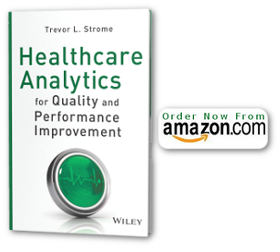As I mention in my Q&A post “What Are the Three V’s of Big Data”, Big Data is a significant topic of conversation in Health Information Technology (HIT) because Healthcare Organizations (HCOs) need to determine how Big Data figures into their operations. The previous post cites a definition of Big Data that states, essentially, that Big Data results from a collection of datasets that can no longer be managed or processed using traditional tools and techniques.
Many healthcare organizations are approaching this seeming Big Data “barrier”. According to HIMSS, three key drivers that are triggering HCOs to seriously look at Big Data architecture and analytics are:
- Healthcare is entering into a “post-EMR deployment” phase where HCOs are now interested in leveraging the vast amount of EMR data being collected to obtain operational and clinical insights that drive institutional changes.
- HCOs are under immense pressure to reduce costs and improve quality of care by “applying advanced analytics to both internally and externally generated data”.
- Larger volumes of structured and unstructured data can now be managed and analyzed through “faster, more efficient and cheaper computing (processors, storage, and advanced software) and through pervasive computing (telecomputing, mobile devices and sensors)”.
There are many kinds of data that are now available and accessible to healthcare organizations for advanced analytics. Some of these sources were outlined in a document I helped author for the Institute for Healthcare Technology Transformation:
- Human-generated data: Although most database systems and analytical tools can handle structured data from source-systems, the challenge for these systems (and for analysis) stems from both the unstructured and semi-structured data increasingly common in electronic medical records (EMRs), physicians’ notes, email, and paper documents. Text mining techniques are one way that data scientists are extracting information from unstructured and semi-structured data so it can be aligned to standard terminologies and coded in ways that can be analyzed with traditional data-mining techniques.
- Web and social media data: Social media platforms such as Facebook, Twitter, Linkedin, blogs, and other emerging media is generating clickstream and interaction data that can be tremendously useful for a variety of purposes ranging from disease surveillance to gauging patient satisfaction and sentiment.
- Machine-to-machine data: The increasing number of connected devices in healthcare facilities is generating terrific volumes of data that includes readings from sensors, meters, and other devices. For example, Radiofrequency Identification (RFID) technology makes it possible to track with high accuracy patient, staff, and equipment locations within a facility but generates a high volume of data that accumulates rapidly. When analyzed appropriately, however, this information is of immense value for examining processes and movements throughout a facility for the purpose of streamlining operations.
- Biometric data: Biometric data includes fingerprints, genetics (i.e., genomics), blood pressure (and other vital signs), medical images, retinal scans, and similar types of data. For example, an individual’s genome can be analyzed to predict how certain medications will be metabolized by a patient to aid physicians in prescribing medications that will have the greatest chance of achieving desired treatment goals with minimum side effects.
As evidenced by the above, the growth of Big Data in healthcare isn’t necessarily driven by one single type or source of data, but rather a combination of sources each made possible through its own series of innovations in information or biomedical technology. It is clear, also, that no one single approach to manage, analyze, and utilize this information will be sufficient to obtain maximum value from these data sources and achieve desired healthcare quality and performance improvements.
Join the conversation! Am I missing any key drivers? Are there any other important sources of data that I’ve missed? Please feel free to leave your comments below.

{ 0 comments… add one now }